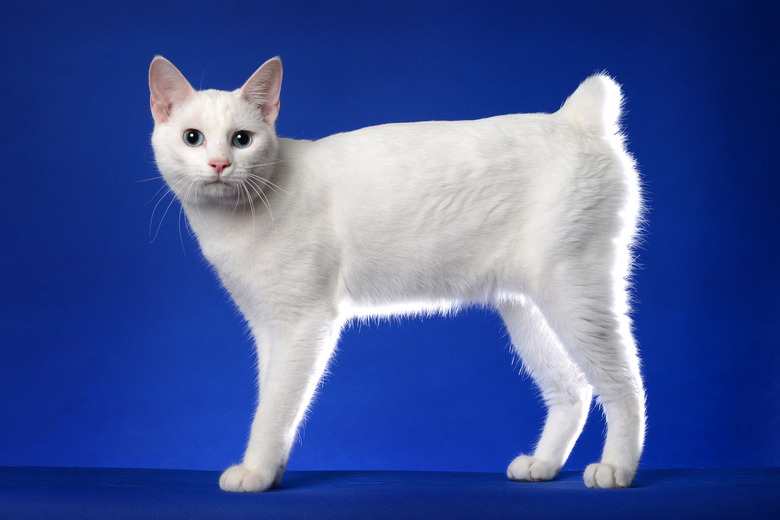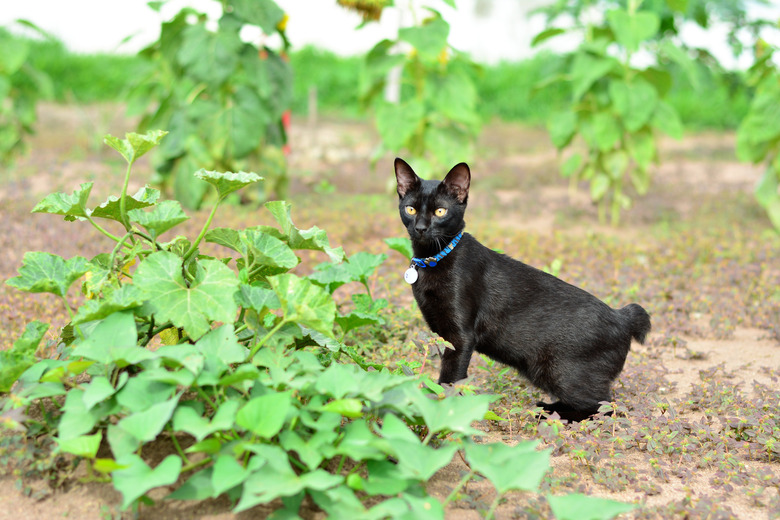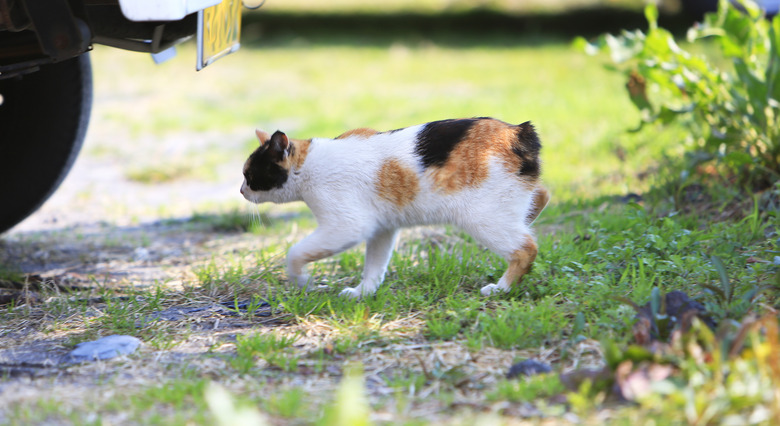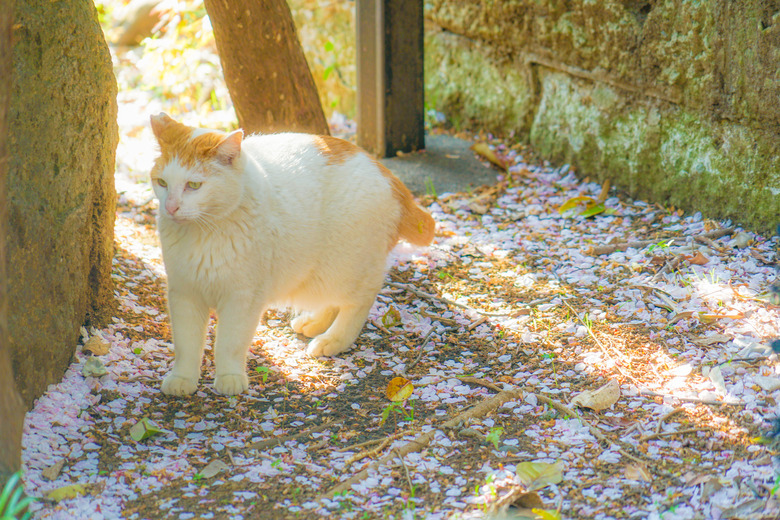Japanese Bobtail Cat Breed Characteristics
Japanese bobtail cat quick facts
Japanese bobtail cat quick facts
Length: 12 – 16 inches
Weight: Females: 5 – 7 pounds, males: 7 – 10 pounds
Lifespan: 9 – 13 years or more
Coat length: Short or long
Coloring: Many colors and patterns, including solid, calico, tri-color, and bi-color
Grooming needs: Low to medium
Friendliness: Breed alone is not an accurate predictor of individual cats' personalities. However, Japanese bobtail cats are generally regarded as loving and playful.
The Japanese bobtail cat is a medium-sized cat and this ancient breed, which is native to Japan, is believed to bring good luck. In fact, you may have seen a figurine of a Japanese bobtail with a raised paw. This is a maneki-neko or beckoning cat. The breed also has a marvelous personality and these active and social cats are sure to bring joy and entertainment to your home. The breed is healthy and easy to care for, so if you are looking for a cat that loves to interact, the Japanese bobtail may be the breed for you.
Japanese bobtail cat history
Japanese bobtail cat history
Domestic cats were first brought to Japan from China or Korea, likely by Buddhist monks between 600 and 700 A.D. Paintings and sketches dating back to the 1500s show images of the Japanese bobtail, including a painting of two longhaired Japanese bobtail cats that is displayed in Washington, D.C. at the Smithsonian Institution's Freer Gallery of Art.
The Japanese bobtail breed was used in the 1600s to get rid of rats that were threatening the silk trade by causing damage in silkworm barns. In Japan, the breed is still a common street cat. Elizabeth Freret brought the breed to the United States in 1968. The Cat Fanciers' Association (CFA) accepted shorthair Japanese bobtail cats for championship status in 1976 and longhair Japanese bobtail cats in 1993.
The Japanese bobtail is not the only breed of short-tailed cats but they are different from the American bobtail and Manx cat breeds. Some distinguishing features noted in the breed standard include:
- a triangular-shaped head
- high cheekbones
- upright ears
- oval eyes
- hind legs that are longer than the front legs
The breed comes in a wide range of patterns and colors. You may see solid colors such as white, cream, blue, red, chocolate, and black. The Mi-Ke, or calico, coloring is one of the most well-known colors for the breed. This is a unique tri-color calico coat pattern. The breed also comes in bi-color and tabby patterns. Any eye color is allowed, including blue and odd eyes, but the eye color should complement the coat color.
The short tail that gives the cat its name is every bit as unique as the breed. No two cats have the same tail. The tail must be visible, but no more than 3 inches long, and have a pom-pom appearance. The cat's tail will often have kinks and curves.
Japanese bobtail cat personality
Japanese bobtail cat personality
The Japanese bobtail would not be described as a lap cat, but that doesn't mean they don't enjoy snuggling with you or crawling under the covers at night. The cats are quite active and having longer back legs means they are excellent jumpers. Expect your Japanese bobtail to run and jump around the house. Consider cat trees or wall shelving that will allow your cat to play.
This breed is intelligent and curious. They will explore every corner of your home. Keep them engaged positively with plenty of play and interactive toys, such as puzzle toys. You can also teach these cats tricks with plenty of positive reinforcement. If you are interested in a social sport with your cat, consider feline agility, as this breed excels at agility skills.
The breed gets along well with children and other pets in the household. They tend to vocalize frequently with melodic chirps and meows. They are people-oriented, so it is best not to leave these cats alone for long periods of time. Fortunately, they usually travel well, so consider taking them with you when you take a long weekend away.
Japanese bobtail cat lifespan and health issues
Japanese bobtail cat lifespan and health issues
The Japanese bobtail is generally a healthy cat that can live 13 years or longer with proper care. There are no known genetic health problems that affect this breed. As with all cats, make sure you take the Japanese bobtail in for regular veterinary check-ups and ensure they stay up-to-date on all recommended vaccinations and parasite treatments.
Japanese bobtail cat grooming and care
Japanese bobtail cat grooming and care
Japanese bobtail cats have silky coats that usually stay free of tangles and mats. Neither the short nor long hair variety has an undercoat which makes grooming easy and means that the cats don't shed as much as some other breeds. Brush or comb the cat's fur regularly to remove any dead hairs. Longhaired Japanese bobtails may need more frequent brushing than shorthair cats, and you may need to brush the cats more often when they are shedding their coat.
In addition, take time to:
- check and trim the cat's nails
- clean the cat's ears
- brush the cat's teeth with a toothpaste that is veterinarian-approved
Feed high-quality cat food as recommended by your veterinarian and make sure clean water is available at all times.
Welcoming a new cat into your home
Welcoming a new cat into your home
Bringing a new kitten or cat into your home is an exciting event, and it is important to take some time to prepare the home before they arrive. Cat-proof the house to remove any toxic plants and anything else that is a danger to your new cat. Remember that these cats are curious and athletic, so don't forget tall shelves and the top of cabinets, and your refrigerator.
Prepare a safe room where your cat can adjust to the new environment and get comfortable with both the human and animal members of your household. Make sure the space has everything your cat may need, including:
- food and water
- litter box
- scratching post
- cat tree
- toys
Allow your cat to explore at their own pace. Don't hold them to be petted until they are ready. Fortunately, these social cats are likely to warm up to you quickly. When your cat is comfortable, open the door to allow the cat access to more of the house. Before you know it, your Japanese bobtail cat will be a playful companion who may even bring good fortune to your life.



